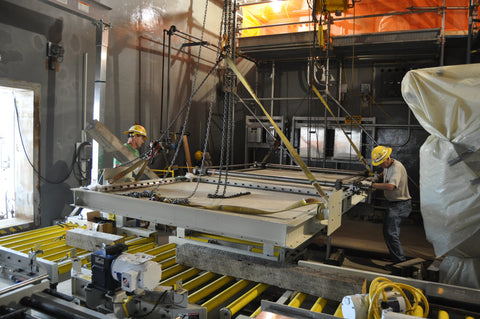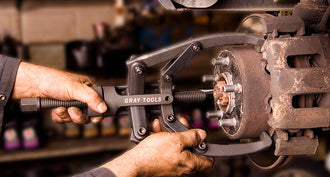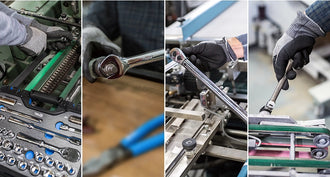A Career as Millwright: Everything You Need To Know
- Gray Tools Official Blog
- 05 Apr, 2016

Millwrights are an elite group of craftsmen who work primarily in metal and with equipment and machinery requiring precision. Nearly every industry requires millwrights, including energy, automotive, refinery, manufacturing, transportation, food processing, pharmaceutical, nuclear, and postal service.
Becoming a professional millwright means joining one of the oldest and most respected trades in the world. If you like working with machines, precision instruments, and tools, and have a keen eye for perfect assemblies, then you have the basic skills to build a stable career for a lifetime.
So, what does a millwright do?
The work of a millwright involves installing, maintaining, diagnosing, and repairing industrial machines that typically cost millions. They work on pumps, compressors, conveyors, turbines, monorails, extruders, and mining equipment using a combination of hand and power tools, including welding equipment.
A millwright may be required to adjust a machine’s calibration for a fraction of a millimetre and increase the productivity of a machine by 20 percent.
Generally, millwrights are conversant with machinery, tool boxes, and power tools, and know how to work with safety as a top priority.
Starting a Career as a Millwright
When it comes to working as a millwright, there are many skills that matter. As a physical job, the applicant’s physical skills matter, but equally important are the candidate’s thinking and communication skills. To get a head start on becoming a millwright, consider taking classes in drafting, mathematics, mechanical drawing, CAD, industrial arts, and enrolling in an industrial shop.
But the actual first step to becoming a millwright is joining an apprentice program, such as that offered by the UBC in North America. When you find an employer to hire you, you can then register as an apprentice, and complete an apprenticeship application/agreement with your employer, which requires information and a signature from both parties. If the apprentice is not a Canadian citizen, a work or study permit will also be required.
An apprentice is essentially a person going through the process of training and acquiring job experience on the path to becoming a skilled millwright. The apprentice is required to attend classroom lessons for a minimum of 1,600 hours per year, as well as on-the-job tuition under the surveillance and guidance of skilled workers of that trade, referred to as journeymen.
The typical length of an apprentice program is four years, with 80 percent of the time spent learning practical on-the-job skills under supervision, and the remaining 20 percent learning the theoretical and technical aspects of the trade. The training is free – and with pay. So, apprentices learn a trade and earn a decent income – simultaneously.
Upon the successful completion of all the technical and practical requirements of the apprenticeship program, signified by a score of 70 percent or more in the final examination, the apprentice receives a Certificate of Qualification confirming their status as a journeyman. At this point, the journeyman also qualifies for inter-provincial or “Red Seal” standing that allows the individual to work across Canada where the “Red Seal” certificate is recognized.
Exception to Becoming a Millwright
It is a requirement that you complete an apprenticeship program before becoming an apprentice. However, if the applicant is already working as a non-unionized millwright, or if the applicant has come from another country with different policies regarding apprenticeship, the applicant may be allowed to use their training or work experience towards certification (in order to become a union member).
Job Expectations
Millwrights typically work 8-hour shifts, except when there’s a machinery breakdown, overtime work, or traveling long distances when splitting shifts may be required.
Apprentices must be prepared to work in any condition: wet or dry, clean or dirty, hot or cold, inside or outside. It is a physical job with plenty of lifting, pushing, pulling, and bending, though apprentices are trained on how to perform these tasks safely before attempting anything like that on a job site. In fact, a millwright must have the right safety attire when going to a work site, including safety glasses, hard hats, safety shoes, and durable clothing.
Salary Expectations
Millwrights are typically paid by the hour, and as union members, they get either time-and-a-half or double-time for all work done beyond the required eight hours.
From the first day of apprenticeship, one can earn a good wage and benefits. Apprentices also get regular raises, usually every six months, until they reach the full journeyman scale at the end of the apprenticeship program.
Some benefits of this approach include:
- Zero school loans or tuition to pay back
- Opportunity to earn while you learn – Since apprentices start earning a wage immediately
- Pay raises – Apprentices earn more and more money as they progress through the program
- Benefits – Health and retirement benefits start right away for the apprentice and his family
Job Security
Professional millwrights are members of the United Brotherhood of Carpenters and Joiners of America (UBC) – an organization that has given many men and women an exceptional quality of life since 1881.
From the first day of apprenticeship, millwrights work for a union contractor under the protection of a union contract that outlines the working conditions, wages, and benefits. In fact, there’s a UBC local in every area whose job is to ensure that all millwrights keep working.




I have multiple full toolbox sets for sale but not sure of the value. Where should research to find true value of I have to sell?
It was a very well researched and well explained article on what is the millwright, its application and importance. No doubt these high equipment and level of industrial mechanics, electricians and machining experts are contributing big time in the development of this country Canada. More and more people are getting interested and growing country’s economy.
Millwright career is very bright due to the fast rise in the industrial setups, advanced machinery and high production demand. A millwright has to study hundreds of hours for onsite and offsite millwright jobs, study and practical classes. They are familiar with heavy mechanical industry and are a valuable part of any society.
Millwright career is bright and full of money making opportunities. The good thing about this field is you get practical experience and in-depth knowledge about advanced machinery, the installation, and repairing process. In Canada, there are lots of millwright apprenticeship and other related jobs which provide job security and handsome money earning opportunities. .
where can i study millwright in southafrica?